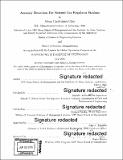Anomaly detection for natural gas regulator stations
Author(s)
Chao, Adam Christopher
DownloadFull printable version (9.895Mb)
Other Contributors
Leaders for Global Operations Program.
Advisor
Saurabh Amin and Georgia Perakis.
Terms of use
Metadata
Show full item recordAbstract
Natural gas regulator stations control the flow of gas across PG&Es gas transmission and distribution system. Ensuring the proper functioning of these-stations is critical for the safety of the natural gas system. Currently, PG&E uses sensors linked to a Supervisory Control and Data Acquisition (SCADA) system to monitor pressure and other characteristics of select regulator stations, with continuing installation of new sensor systems across the network. PG&E seeks to develop algorithms for detection and prediction of safety issues before they occur, as well as monitor performance degradation in a regulator station. First, analysis of historical failure events was conducted to better understand the varying causes of regulator overpressure events and their corresponding downstream pressure patterns. Then, downstream pressure time-series data was collected and processed for each regulator station. Useful features from these time-series were extracted, including day-today changes and moving averages. Piecewise linear segmentation was also performed on the time-series to extract relevant features. These features were then used to cluster stations by their operating characteristics, grouping stations with similar volatility and pressure patterns. Anomaly detection methods were then developed and calibrated for the station clusters. We use a variety of statistical process control techniques, including CUSUM and EWMA to detect changes in the behavior of a regulator downstream pressure time-series. Detection algorithms were then evaluated with and without clustering using ROC curves on simulated pressure anomalies. Ultimately, we show that modified CUSUM and adaptive sliding window techniques can detect pressure anomalies in natural gas regulators with reasonable false positive rates. We also show how improvements to data handling and sharing at PG&E can facilitate better algorithms for regulator anomaly detection.
Description
Thesis: M.B.A., Massachusetts Institute of Technology, Sloan School of Management, 2016. In conjunction with the Leaders for Global Operations Program at MIT. Thesis: S.M. in Engineering Systems, Massachusetts Institute of Technology, School of Engineering, Institute for Data, Systems, and Society, 2016. In conjunction with the Leaders for Global Operations Program at MIT. Cataloged from PDF version of thesis. Includes bibliographical references (pages 61-63).
Date issued
2016Department
Leaders for Global Operations Program at MIT; Massachusetts Institute of Technology. Engineering Systems Division; Massachusetts Institute of Technology. Institute for Data, Systems, and Society; Sloan School of ManagementPublisher
Massachusetts Institute of Technology
Keywords
Sloan School of Management., Institute for Data, Systems, and Society., Engineering Systems Division., Leaders for Global Operations Program.